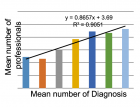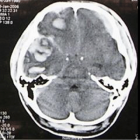Abstract
Research Article
Magnets, Gradients, and RF Coils of MR Scanners
Željko Đ Vujović*
Published: 25 July, 2023 | Volume 6 - Issue 2 | Pages: 128-135
The topic of this paper is the parts of modern MR devices, which contain magnet coils. MR scanner magnets are made of four types of electromagnetic coils: 1) Main magnet, made of superconducting material. The main magnet of an MR (Magnetic Resonance Imaging) scanner creates a strong and uniform magnetic field around the patient being scanned. This magnetic field is typically in the range of 0.5 to 3 Tesla and is used to align the magnetic moments of the hydrogen atoms in the patient's body. The superconductors, which create the main magnetic field, should be cooled with liquid helium and liquid nitrogen. The main magnets made of superconductors should use a cryostat, with cooling vessels with liquid helium and liquid nitrogen, thermal insulation, and other protective elements of the magnet system. 2) The gradient magnetic field is made of three types of coils: x-coils, y-coils, and z-coils. The X coil, made of resistive material, creates a variable magnetic field, horizontally, from left to right, across the scanning tube; 3) The Y coil creates a variable magnetic field, vertically, from bottom to top; 4) The Z coil creates a variable magnetic field, longitudinally, from head to toe, inside the scanning tube. RF coils are used to generate RF pulses to excite the hydrogen protons (spins) in the patient's body and detect the signals emitted by the protons when they return to their equilibrium state after the RF excitation is turned off. The resulting interaction between the magnetic field and the aligned hydrogen atoms produces a signal that is used to generate the images seen in an MRI scan. The main magnetic field is what allows MR imaging to produce detailed anatomical and functional information non-invasively. The structure of the MR scanner magnet is complex. The resonant frequency changes at each point of the field in a controlled manner. Inside the copper core are embedded the windings of the main magnet made of superconducting material in the form of microfibers. A non-linear gradient field is created by coils of conductive material. It adds to the main magnetic field. Thus the resulting magnetic field is obtained. The types of magnets that exist in the basic configurations of MR scanners are analyzed. Scanners in the form of a closed cylindrical cavity generate their magnetic fields by passing current through a solenoid, which is maintained at the temperature of a superconductor. Exclusively used superconductors are niobium-titanium (NbTi), niobium-tin (Nb3Sn), vanadium-gallium (V3Ga), and magnesium-diboride (MgB2). Only magnesium diboride is a high-temperature superconductor, with a critical temperature Tc = 390K. The three remaining superconductors are low temperatures. New high-temperature superconductors have been discovered, as well as superconductors at room temperature. Newly discovered superconducting materials are not used in MR scanners.
Read Full Article HTML DOI: 10.29328/journal.ijpra.1001062 Cite this Article Read Full Article PDF
Keywords:
Main magnet; MR scanners; Cryostat; Superconductors; Gradient magnetic field; RF coils; Magnetic resonance
References
- Elster DA, MR magnet types. (Accessed 18.07.2023.). Questions and Answers in MRI. https://mriquestions.com/types-of-magnets.html
- Elster DA, Magnets II. (Accessed 18.07.2023.). Questions and Answers in MRI. https://mriquestions.com/magnets---part-ii.html
- Elster DA, Magnetic gradients. (Accessed 18.07.2023.). Questions and Answers in MRI. https://mriquestions.com/gradients.html
- Elster DA, RF and Coils. (Accessed 18.07.2023.). Questions and Answers in MRI. https://mriquestions.com/rf--coils.html
- Overweg J, MRI main magnets, Presented ISMRM 2006.
- Cosmus TC, Parizh M. Advances in Whole-Body MRI magnets. IEEE Transactions on Applied Superconductivity. 2011; 21(3): 2104–2109. https://doi.org/10.1109/tasc.2010.2084981
- Bardeen J, Cooper LN, Schrieffer JR. Theory of Superconductivity. Physical Review. 1957; 108:5.
- Flukiger R. MGB2 superconducting wires: Basics and Applications. World Scientific. 2016.
- Siemens Healthcare Gmbh©2023 Corporate, MAGNETOM Terra. (Accessed28.04.2023.). https://www.siemens-healthineers.com/magnetic-resonance-imaging/7t-mri-scanner/magnetom-terra
- J Eck. Superconductors. (Accessed 29.04.2019.). http://www.superconductors.org/
- Mri coils, Slideshare, Jun 28, 2020, slide 17, Mri coils. (Accessed 19.07.2023.). https://www.slideshare.net/sonysahs/mri-coils
- Jaiswal D. Applications and Comparison of Medical Imaging Modalities. 2018. https://www.semanticscholar.org/paper/Applications-And-Comparison-of-Medical-Imaging-Jaiswal/a2e07302941a378d9666dbe2d90788507516533c
- Elster DA, Superconductive magnet design. (Accessed 19.07.2023.). Questions and Answers in MRI. https://mriquestions.com/superconductive-design.html
- Elster DA, Gradient coils. (Accessed 19.07.2023.). Questions and Answers in MRI. https://mriquestions.com/gradient-coils.html Gradient coils
- Elster DA, Z-gradients. (Accessed 19.07.2013.). Questions and Answers in MRI. https://mriquestions.com/how-do-z-gradients-work.htmlZ–gradients
- Mri gradient coils, slide 18. (Accessed 19.07.2013.). https://www.slideshare.net/ShahnawazKhan277/mri-gradient-coils
- Elster DA, RF transmit coils. (Accessed 19.07.2023.). Questions and Answers in MRI. https://mriquestions.com/rf-transmit-coils.html
- Elster DA, Receive only MR coils. (Accessed 19.07.2023.). Questions and Answers in MRI. https://mriquestions.com/receive-only-coils.html
- Elster DA, Radiofrequency (RF) – Shielding. (Accessed 20.07.2023). https://mriquestions.com/why–rf–shielding. html
- Glossary of MRI Terms, American College of Radiology. ACR.org home. (Accessed 20.07.2023.). https://www.acr.org/
- Elster DA, Larmor Frequency. (Accessed 20.07.2023). https://mriquestioncom./why–at–Larmor–frequency. html
- Elster DA, Magnetic Field Gradient Defined. (Accessed 20.07.2023). https://mriquestions.com/what–is–a–gradient. html
- Elster DA, Radiofrequency Coils. (Accessed 20.07.2023). https://mriquesti2ons.com/rf–coil–functions. html
Similar Articles
-
Pristine and Fullerene between Hasselmann and Van HasseltWidastra Hidajatullah-Maksoed*. Pristine and Fullerene between Hasselmann and Van Hasselt. . 2023 doi: 10.29328/journal.ijpra.1001060; 6: 119-120
-
Magnets, Gradients, and RF Coils of MR ScannersŽeljko Đ Vujović*. Magnets, Gradients, and RF Coils of MR Scanners. . 2023 doi: 10.29328/journal.ijpra.1001062; 6: 128-135
-
3-D Current Density and Magnetic Field of 3-D MR Scanner Gradient CoilŽeljko Đ Vujović*. 3-D Current Density and Magnetic Field of 3-D MR Scanner Gradient Coil. . 2024 doi: 10.29328/journal.ijpra.1001090; 7: 086-092
Recently Viewed
-
Association Between Electrocardiographic Abnormalities and In-Hospital Adverse Outcome in COVID-19 PatientsAnjuman Begum*, Wadud Chowdhury, Suman KS, Arnab KC, Md. Akteruzzaman, Barua Sushanta. Association Between Electrocardiographic Abnormalities and In-Hospital Adverse Outcome in COVID-19 Patients. J Cardiol Cardiovasc Med. 2024: doi: 10.29328/journal.jccm.1001196; 9: 148-152
-
Maximizing the Potential of Ketogenic Dieting as a Potent, Safe, Easy-to-Apply and Cost-Effective Anti-Cancer TherapySimeon Ikechukwu Egba*,Daniel Chigbo. Maximizing the Potential of Ketogenic Dieting as a Potent, Safe, Easy-to-Apply and Cost-Effective Anti-Cancer Therapy. Arch Cancer Sci Ther. 2025: doi: 10.29328/journal.acst.1001047; 9: 001-005
-
Parents’ perception of the school nurse’s roleDiane Gillooly*,Ganga Mahat,Patricia Paradiso. Parents’ perception of the school nurse’s role. J Adv Pediatr Child Health. 2020: doi: 10.29328/journal.japch.1001021; 3: 064-067
-
Plant growth, Yield and Leaf Nutritional value of Jute (Corchorus olitorius L.) as Influenced by Banana Peel levels under Salt Stress conditions in Coastal region of CameroonMathias Julien Hand*,Chimène Fanta Abib,Kingsley Mbi Tabi,Alphonse Ervé Nouck,Libert Brice Tonfack,Victor Désiré Taffouo,Emmanuel Youmbi. Plant growth, Yield and Leaf Nutritional value of Jute (Corchorus olitorius L.) as Influenced by Banana Peel levels under Salt Stress conditions in Coastal region of Cameroon. J Plant Sci Phytopathol. 2024: doi: 10.29328/journal.jpsp.1001145; 8: 131-140
-
Dynamics of Siberian Fir Stands in Forest Ecosystems of Eastern Sayan SpursBazhina Elena Vasil’evna*,Pavel I Aminev. Dynamics of Siberian Fir Stands in Forest Ecosystems of Eastern Sayan Spurs. J Plant Sci Phytopathol. 2024: doi: 10.29328/journal.jpsp.1001146; 8: 141-143
Most Viewed
-
Evaluation of Biostimulants Based on Recovered Protein Hydrolysates from Animal By-products as Plant Growth EnhancersH Pérez-Aguilar*, M Lacruz-Asaro, F Arán-Ais. Evaluation of Biostimulants Based on Recovered Protein Hydrolysates from Animal By-products as Plant Growth Enhancers. J Plant Sci Phytopathol. 2023 doi: 10.29328/journal.jpsp.1001104; 7: 042-047
-
Sinonasal Myxoma Extending into the Orbit in a 4-Year Old: A Case PresentationJulian A Purrinos*, Ramzi Younis. Sinonasal Myxoma Extending into the Orbit in a 4-Year Old: A Case Presentation. Arch Case Rep. 2024 doi: 10.29328/journal.acr.1001099; 8: 075-077
-
Feasibility study of magnetic sensing for detecting single-neuron action potentialsDenis Tonini,Kai Wu,Renata Saha,Jian-Ping Wang*. Feasibility study of magnetic sensing for detecting single-neuron action potentials. Ann Biomed Sci Eng. 2022 doi: 10.29328/journal.abse.1001018; 6: 019-029
-
Pediatric Dysgerminoma: Unveiling a Rare Ovarian TumorFaten Limaiem*, Khalil Saffar, Ahmed Halouani. Pediatric Dysgerminoma: Unveiling a Rare Ovarian Tumor. Arch Case Rep. 2024 doi: 10.29328/journal.acr.1001087; 8: 010-013
-
Physical activity can change the physiological and psychological circumstances during COVID-19 pandemic: A narrative reviewKhashayar Maroufi*. Physical activity can change the physiological and psychological circumstances during COVID-19 pandemic: A narrative review. J Sports Med Ther. 2021 doi: 10.29328/journal.jsmt.1001051; 6: 001-007

HSPI: We're glad you're here. Please click "create a new Query" if you are a new visitor to our website and need further information from us.
If you are already a member of our network and need to keep track of any developments regarding a question you have already submitted, click "take me to my Query."



















































































































































